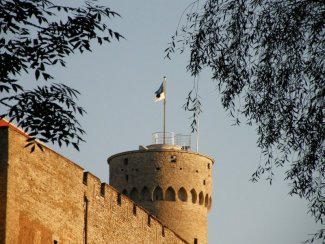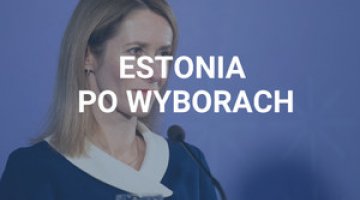Seeking an additional reassurance. The EU and France in Estonia’s security policy

Over the last few years, Tallinn has been increasingly involved in military cooperation in the EU and with France. To date, Estonia is the only country on NATO’s eastern flank to join the French-led European Intervention Initiative. The country is developing the European pillar of its security policy with a view to diversifying military cooperation, which has centred primarily around the US and UK. This is due to Estonia’s concerns about the future of their military posture in Europe. However, due to the leading role of the US and UK in NATO’s deterrence and defence on the eastern flank, working with the two countries will continue to be Estonia’s security policy priority.
Apart from involvement in a number of PESCO projects, Estonia is focused on expanding its participation in the EU defence industrial cooperation. In June 2020, five Estonian-based entities received over EUR 10 million from the European Defence Industrial Development Programme, making this small country the main Central and Eastern Europe recipient of the programme funds. Estonia is also increasing its contribution to French military operations. In July 2020, roughly fifty Estonian special forces troops were sent to Mali to reinforce the French operation Takuba in the Sahel.
A new outlook on the CSDP
Since Estonia joined the EU in 2004, it has taken a series of CSDP initiatives with a pinch of salt, due to a fear that NATO would be duplicated, and that transatlantic ties crucial for the Baltic states would be undermined. Another concern was that the EU was placing too much stress on threats from the southern neighbourhood. Here, political and strategic considerations were coupled with practical problems. Being one of the smallest NATO and EU countries, Estonia does not have the financial, administrative, or military capacity to become fully involved in new cooperation formats if it is not confident that this will truly bolster the country’s security. This has led Estonia to strictly define its military cooperation priorities. It can be seen for example by Estonia’s engagement in foreign operations, in which it is concerned with making a valuable contribution rather than seeking a symbolic presence in the largest number of missions possible. The withdrawal of ships from the Baltic Naval Squadron (BALTRON) also signifies this approach.
Estonia’s new outlook on the CSDP has been caused above all by shifts in US foreign and security policy that followed when Donald Trump took office. The lack of permanent US military presence on Estonian soil since 2017 – as part of the NATO enhanced Forward Presence (eFP) or bilaterally – was also a major factor (from 2014 until 2017, the US had a permanent rotation of a company-size unit in Estonia, as it did in Lithuania, Latvia, and Poland). Brexit and the following Franco-German military cooperation initiatives in the EU have also contributed to a change in Estonia’s approach towards the CSDP. Due to Brexit Estonia took over the UK’s presidency of the Council of the EU in the latter half of 2017, at a time when the most crucial decisions concerning further development of the CSDP were being made. Cooperation between France and Estonia during that presidency led to greater involvement of Estonian politicians and officials in plans to enhance EU military cooperation, which were incorporated into the presidency programme.
Estonia also decided to take an active part in initiatives such as permanent structured cooperation (PESCO) or the European Defence Fund. Developing the cooperation with European allies allowed Estonia to partly diversify its firmly pro-Atlantic security policy. Despite this, the CSDP is paid relatively little attention in Estonian security policy debate, which focuses on NATO and transatlantic relations. The government and political parties comment sparingly on the CSDP, favouring the ‘NATO first’ principle, and emphasising the importance of EU cooperation in ‘soft security’ matters such as terrorism, illegal immigration, border protection, and the role of NATO-EU cooperation. The Estonian view is fittingly summarised by the words of a former commander of Estonia’s armed forces, General Riho Terras, who sees development of the CSDP primarily as investments in new technology, improved operational capability, and an opportunity to develop NATO’s European pillar. For defence minister Jüri Luik, it is important to put EU military cooperation projects into practice, which should translate into the rise in defence expenditures on the part of the European allies[1].
Within the CSDP, Estonia has set itself feasible goals, which are to attain specific military capabilities, promote its own expertise (cyber defence), and to improve military mobility, which is crucial for timely reinforcement of the eastern flank. This is especially important to a frontier state located at a considerable distance from its major allies. Tallinn sees EU instruments such as the European Defence Fund as a means of developing its own fledgling defence industry, which consists of small firms that invest in developing a number of niche capabilities (cyber defence, robotics, border surveillance systems). As there is little scope for absorption on the Estonian market, these firms seek international projects and EU financing to allow them to break into other markets.
Estonia is involved in three PESCO projects: Military Mobility (‘Military Schengen’), Cyber Rapid Response Teams and Mutual Assistance in Cyber Security, and Integrated Unmanned Ground Systems. In the latter one it is leading the project, which also involves Finland, France, Spain, Germany, Belgium, and Latvia. Besides, Tallinn is focused on industrial cooperation. In June 2020, the European Commission announced that further projects would be financed under two pilot programmes before the European Defence Fund is introduced in 2021: Preparatory Action on Defence Research (PADR), and the European Defence Industrial Development Programme (EDIDP). Out of the applications reviewed for funding under the EDIDP for 2019, four Estonian firms and the Military Academy, taking part in four projects, received over EUR 10 million out of a total of 500 million available for the period 2019–2020[2]. Estonia therefore was the Central and Eastern Europe country to benefit the most under the programme. In this instance, the main player is Milrem Robotics, which has taken the leading role in the Integrated Modular Unmanned Ground System (iMUGS) project.
Estonia’s activity within the CSDP is aligned with the approach taken by the two other Baltic states from 2017 onwards[3]. All Baltic states wish European military cooperation to be a vital element of transatlantic relations, and so to improve those relations, and not exacerbate the divisions. Like Estonia, Lithuania and Latvia are also taking part in three PESCO projects, and would like to see a ‘Military Schengen’ established. These two countries stress the importance of EU members being able to fend off hybrid threats, especially cyberattacks. Latvia also realises the potential of military medicine projects. To a certain extent, the interests of the Baltic states in EU defence industry support programmes are aligned, due to their industries being structured in similar ways, and because they have similar strategies for modernisation of the armed forces (still based on acquiring second-hand armaments and military equipment in many cases). Vilnius and Riga are, however, more focused on cooperation with the US in terms of military investments, leading them to be less interested in European defence industrial projects.
Setting a course: France
While increasing its CSDP involvement, Estonia has visibly expanded its military cooperation with France in recent years. In June 2018, it became the first country on NATO’s eastern flank to join the European Intervention Initiative (EI2). This French-led undertaking is aimed at developing a shared strategic culture among the member countries and capability to act together in military operations within the EU, NATO, the UN and/or ad hoc coalitions. From the point of view of defence minister Jüri Luik, cooperation in monitoring of threats to European security – both from the south and the east – and development of a rapid crisis response capability are important elements of the EI2[4].
Tallinn has also been involved in France’s operations in the Sahel. Roughly 70% of all Estonian troops participating in international missions are currently in Mali – bolstering the French-led Barkhane and Takuba operations (in total 95 troops) and the EU Training Mission and the UN MINUSMA (20 troops altogether). Estonia was France’s first ally to join operation Barkhane (September 2018), and remains the only ally that has deployed land forces (mechanised infantry platoon with armoured personnel carriers)[5]. It was also the first to agree to a request from Paris to send special forces (50 troops) to the Sahel in connection with operation Takuba. The deployments to Africa put the greatest military and financial burden on Estonia since its participation in the NATO ISAF operation in Afghanistan. Estonia’s armed forces are a mere 6,300 in number, of which half are conscripted and do not take part in foreign missions. In addition, since 2017, some of Estonia’s regular forces have been focusing on exercises with the NATO battlegroup at home.
Estonia stands out among the Baltic states due to its close defence cooperation with France. To date, Lithuania and Latvia have not joined the EI2 and do not play such an active role in the Sahel (although over 40 Lithuanian troops are deployed to MINUSMA, as a part of the German detachment). Vilnius prioritises cooperation with the US, Germany – the NATO battlegroup framework nation in Lithuania (where there is also rotation of French troops) – and Poland. For Riga, military cooperation with the US, and increasingly with Canada – the NATO battlegroup framework nation in Latvia – is crucial. President Emmanuel Macron’s visit to Lithuania and Latvia at the end of September 2020 may move both countries closer to France with respect to defence matters in the future.
Forging closer military ties between France and Estonia may be surprising, because the two countries are not only divided geographically, but also by their perception of threats (the south versus the east), their approach to Russia (dialogue versus deterrence) or also their approach to the US (EU strategic autonomy versus transatlantic mindset). Growing uncertainty in Tallinn as to the future of the US and UK military posture in Europe provides a broader context for the increased importance of France in Estonia’s security policy. This relates especially to the intensifying global rivalry between the US and China, which could lead to greater US military involvement in South-East Asia. Donald Trump’s ‘America First’ is interpreted ambiguously in Tallinn. While that presidency has meant greater US military activity in the Nordic-Baltic region, and greater support for the Baltic states, Estonia is concerned about casting doubts on the endurance of the transatlantic relationship, including US commitment to collective defence under Article 5, and about undermining the role of international organisations such as NATO and the EU. The Trump administration’s image has suffered additionally due to decisions to redirect some financing, including funds allocated for a special forces base in Estonia, from the European Deterrence Initiative (EDI) to build Trump’s Mexico wall (2019), and due to decisions to reduce the permanent US military presence in Germany by 6,400 (2020)[6]. Tallinn is also worried about the possible negative effects of Brexit and the COVID-19 pandemic on the UK’s security policy – such as growing tensions between London and the EU member states, or cuts in UK defence spending. In addition, Estonia is monitoring carefully the UK’s plans to increase its military involvement in South-East Asia and possible reductions in the land forces and amphibious infantry, which is being discussed in light of ongoing work on a new strategy for the UK’s foreign and security policy.
Tallinn also considers development of military cooperation with Paris to be part of a long-term political investment to anchor France – a nuclear power, UN Security Council permanent member, and continental Europe’s most powerful military – more firmly to the eastern flank. From Estonia’s perspective, its involvement in the French-led EI2 serves this purpose among other things. In this regard, Tallinn is applying similar logic as in the case of joining the UK-led Joint Expeditionary Force (JEF). It sees this as a means of demonstrating a readiness to provide spot reinforcements for the major allies in operations outside of Europe, counting, in return, on their greater sensitivity to the threats in the Baltic Sea region, which would enhance deterrence towards Russia. For Tallinn, one of the motivations behind assisting France in the Sahel is its rotational involvement in the UK-led NATO battlegroup in Estonia. This biennial contribution consists of a mechanised infantry unit of 300 troops (rotating with Denmark and Belgium). France also regularly provides fighter jets for NATO Baltic Air Policing (BAP).
There is much evidence that expanding military cooperation with France comes primarily at the initiative of defence minister Jüri Luik, who has held that function since 2017. This is because there is almost no mention of France in Estonian government strategic documents or political parties’ manifestos. These in fact place more emphasis on the cooperation with the US, the UK, or Nordic-Baltic countries. In turn, expert community discusses the relationship between French rhetoric on European security and its real military capabilities. Unlike in the Nordic countries, in Estonia there is no debate about the reasons for France’s military engagement in Africa and resulting gains or losses.
Part of a larger arrangement
Closer military cooperation in the EU and with France is a factor complementing a crucial dimension for Estonia, which is development of transatlantic relations. Even though there is an increasing awareness that the post-Cold War order is not something that Estonia can take for granted, and despite enhancing the European pillar of the country’s security policy, NATO membership and cooperation with the US are still central to its strategic culture.
Tallinn sees NATO collective defence and allied military presence in Estonia as the best guarantee of an effective deterrent against Russia. From Estonia’s perspective, the security of the eastern flank has been improved following the 2016 NATO Warsaw summit, chiefly due to the deployment of the NATO battlegroups to Poland and to the Baltic states (eFP). For Tallinn, decisions to increase NATO’s capability for conducting a major collective defence operation were also important, such as enhancing: the NATO Response Force, the combat readiness of the forces of the member states (NATO Readiness Initiative), and the NATO Command Structure and NATO Force Structure. The latter concerns in particular the creation of the Headquarters Multinational Division North (MND N), in which Estonia is a framework nation, in addition to Denmark and Latvia.
Equally, Estonia considers NATO’s involvement in the Baltic Sea region to be incomplete, pointing out shortcomings in defence of the north-eastern flank. One of its proposals is that the allied military presence in the region should include maritime and air defence components in addition to the land forces. In the case of protection of skies, it would like to see NATO BAP transformed into a Baltic air defence mission, equipped with medium-range surface-based air defence systems in addition to fighter jets. Moreover, from Tallinn’s viewpoint, NATO needs to regularly exercise deployment of ‘follow-on forces’ to the eastern flank, which are designed to reinforce the national forces, NATO Very High Readiness Joint Task Force, and eFP battlegroups.
From Estonia’s perspective, whose defence depends on a timely NATO response, the divisions between the member states, which could impact the alliance’s unity in a crisis, are especially worrying. They are exacerbated for example by tensions between the US and Western European allies regarding the respecting of defence capabilities and military spending pledges, or by Turkey blocking an adjustment to the NATO contingency plans for Poland and the Baltic states.
In relations with the US, despite the fears described above as to Trump administration’s security policy, Tallinn is seeking the closest possible defence cooperation with the US and to ensure that Washington maintains its commitment to security of the Baltic states. Estonia has called for the greatest possible US military presence in Europe on many occasions, the further forward on the eastern flank the better. From Tallinn’s point of view, the US military footprint is particularly important as a deterrent towards Russia. When plans were revealed to withdraw some US troops from Germany, Estonia suggested that they could be hosted on its soil. In Tallinn it has not been forgotten that the US was the first ally to deploy forces to the Baltic states in response to the annexation of Crimea. Besides, the US reinforced its military presence there during the Russian-Belarusian Zapad 2017 exercises. In recent years, the US – as a part of the operation Atlantic Resolve – also organised the largest military exercises in Lithuania, Latvia, and Estonia (for instance US Army Saber Strike and maritime BALTOPS). Finally, US Air Force exercises are also valuable for Tallinn, as they demonstrate the capability to provide quick military assistance to Estonia.
In addition to the US military activity in Estonia and the region, the US defence department’s aid in modernising Estonia’s armed forces is an important aspect of bilateral cooperation. This concerns EDI financing for development of Estonia’s military infrastructure (Ämari Air Base and Tapa Army Base) and supply of Javelin anti-tank missiles, unmanned aircraft systems, large-calibre ammunition, and high-frequency radios. In 2015–2019, the US military aid for Estonia came to USD 260 million (compared with just under USD 70 million in the years 1998–2014)[7].
There is also no indication that the UK will cease being a NATO battlegroup framework nation in Estonia in the coming years, as Estonia is the UK’s most important foothold on the eastern flank. For all of the Baltic states, participation in the UK-led JEF demonstrates a long-term strategy for expanding military cooperation with the UK. The JEF exercises conducted in 2019 (Baltic Protector), which included Royal Marines amphibious landing in Estonia, indicate that this expeditionary force will also be operationally involved in the Baltic Sea region.
With regard to security policy, Estonian political parties are essentially pro-Atlantic. This is also the dominant trend in public debate and in the media, although public opinion is more diverse in this respect, due to the division into Estonian- and Russian-speakers (about 30% of the population). This polarisation is apparent for instance in the case of attitudes to NATO, which is trusted by 77% of the Estonian-speaking community, and only 35% of the Russian-speakers (research conducted in 2019[8]). Support for NATO membership is 90% among Estonian-speakers and 44% among Russian-speakers, and for the presence of NATO forces in Estonia – 91% and 37% respectively. Only 27% of Russian-speaking respondents agreed that the NATO battlegroup contributes to the country’s security, while this figure was 77% among Estonian-speakers. The two groups also differ in their attitudes towards the US, which is considered a threat to peace and security by 28% of Estonian-speakers and by 41% of Russian-speakers. In contrast, the attitude towards closer military cooperation within the EU stands out in these opinion polls. There is broad public support for such cooperation (73% of respondents), and the existing gap between Estonian- and Russian-speakers is smaller (78% and 61% in favour respectively). This is not only an incentive for Estonia to play an active part in the CSDP, but also an opportunity to increase the level of public approval for the country’s security policy, beyond ethnic and language divides.
[1] V. Veebel, ‘Estonia on the Road to a European Army’ [in:] H.-P. Bartels, A.-M. Kellner, U. Optenhögel (eds.), Strategic Autonomy and the Defence of Europe: On the Road to a European Army, Dietz Verlag, May 2017; Idem, ‘Would PESCO and a European Army Make Estonians Feel More Secure?’ [in:] One Europe – One Army? On the Value of Military Integration, Zentrum für ethische Bildung in den Streitkräften, February 2018, pp. 38–43, www.ethikundmilitaer.de.
[2] ‘Estonian projects won more than EUR 10 million from the European Defence Fund’, Ministry of Defence of the Republic of Estonia, 16 June 2020, www.kaitseministeerium.ee.
[3] M. Šešelgytė, PeSCo: the Lithuanian Perspective, Ares Group, September 2018, www.iris-france.org; Idem, Armament and Transatlantic Relationships: the Baltic States Perspective, Ares Group, November 2019, www.iris-france.org; D. Palavenis, ‘Lithuania in European Union common security and defence policy context’, Security and Defence Quarterly, June 2019, Vol. 25, No. 3, pp. 15–36; V. Bodnieks, European Union Common Security and Defence Policy: implications and future perspectives for Latvia, ECPR, September 2019, www.ecpr.eu.
[4] ‘Estonia joins European Intervention Initiative’, Ministry of Defence of the Republic of Estonia, 26 June 2018, www.kaitseministeerium.ee.
[5] As at July 2020. This is not the first time that Estonia has been engaged militarily alongside France. It was also involved in EU operations in the Horn of Africa and Chad, and UN mission in Lebanon. K. Stoicescu, M. Lebrun, Estonian-French Defence Cooperation: Where Estonian Pragmatism Meets French Vision, ICDS, August 2019, www.icds.ee; K. Stoicescu, Stabilising the Sahel: The Role of International Military Operations, ICDS, July 2020, www.icds.ee.
[6] S. Sakkov, ‘A view from the frontline: Estonian experience’ [in:] Mark Ozawa (ed.), The Alliance Five Years after Crimea: Implementing the Wales Summit Pledges, NATO Defense College, December 2019, pp. 47–57, www.ndc.nato.int.
[7] ‘USA Military Aid to Estonia’, Ministry of Defence of the Republic of Estonia, www.riigikaitseareng.ee.
[8] Public Opinion and National Defence, Ministry of Defence of the Republic of Estonia, March 2019, www.kaitseministeerium.ee.





